
08 Nov TIO SE Asia: Hanoi So Far (So Good)

Approaching Hanoi
First impressions, as capital cities go, Hanoi is not particularly prepossessing. It lacks the sensual grace of Paris and the raw muscle of New York. On the surface, Hanoi feels more like Athens: in-your-face history, a pile-up of facts, figures and folklore, juxtaposed to serviceable structures for work and play – although the saffron exterior of government buildings makes them stand out in the landscape, even the infamous “Hanoi Hilton,” the color softening the hard edges of the business of bureaucracy.
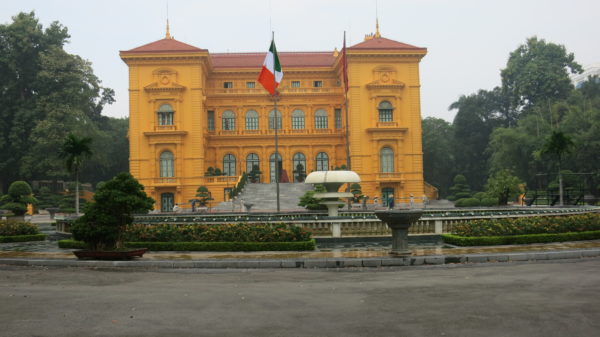
Truth be told the best architecture in town is on the chiseled faces of its beautiful people. Cheekbones that could cut glass frame smiles for miles. And theirs is the kind of beauty that comes from the inside.

Every single person we’ve encountered so far, most admittedly in the service sector, from the doll-faced guide in the lacquer factory to the waitresses at local restaurants, drivers, hotel staff, especially our guides, has been warm and welcoming, eager to please, well-trained, and well-informed. They wear their jobs like prom dresses (or suits), not ill-fitting uniforms. And there was not a trace of resentment for the bad behavior of the Western powers like us, who, in our ignorance and arrogance, attempted to take over the country and crush the culture. (Although we were told Vietnamese describe the French as “bloodsuckers” because they came, they saw, they conquered – but only for awhile and not completely – then they left with everything that wasn’t nailed down.) We were somewhat surprised and quite humbled by the obvious lack of rancor in everyone in our path.
True, Hanoi is a communist city in a communist country, but forget tired cliches from Bond flicks: trench coats, gold teeth and hard, cold eyes. All work, no play, does not apply here. From what we have heard so far – and yes, despite what most guide books say, talk about government is not off-limites – these are not lives lived in the shadows.
Quite the contrary.
Strolling home from our massages at the serene, sensual Anam Spa – highly skilled therapists, highly recommended – we watched large groups of young people playing Simon Says with a leader shaking her booty doing a Vietnamese version of flash dancing.
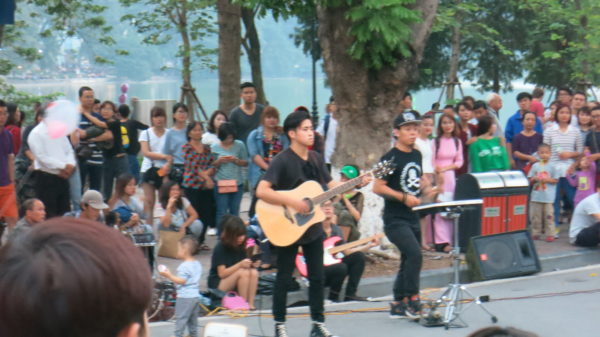
We stopped to listen to a trio led by a flutist playing music on a promenade as a huge crowd listened attentively and showed their appreciation by filling a guitar case at the center of the circle with what looked like a bundle of money – but then in Hanoi the exchange rate is $ 1 U.S. = 22, 505 dong.
We witnessed a pint-sized variation on the theme of a Demolition Derby: tiny tots driving miniature electric cars down what on weekdays are roiling thoroughfares. Future Tesla drivers of the world unite!
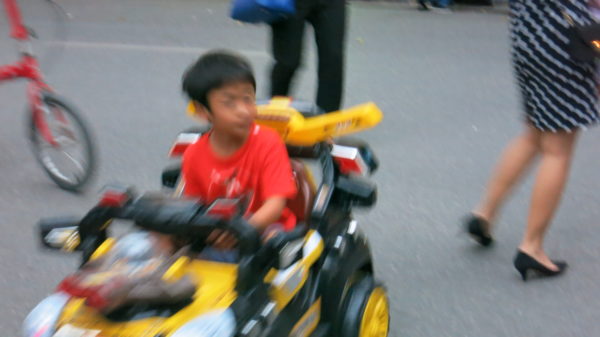
It was a mellow yellow Sunday afternoon, but on most days, the name of the game in town is chicken.
Hanoi has traffic lanes, but very few traffic lights and way too many vehicles, all spewing exhaust like insults 360 degrees around. (The scene is Bill McKibben’s worst nightmare.) To put “too many” in perspective, the population of the city is roughly 7 million, with about 3 million living downtown. The population of scooters? About 9 million.
We think of communist countries as having all kinds of rules and regulations, but Darwin, not Marx, reigns supreme on Hanoi’s mean streets.
We experienced the mayhem up close and personal on our first evening in town (Saturday, November 5). Following a bucket-list event, a water puppet show (at the Viet Nam Contemporary Art Theatre), we were “treated” to a earsplitting, heart-stopping tour of the city’s oldest, liveliest commercial district, Old Town, its streets named for the goods sold by chockablock vendors.

But still, when all was said and done – once we pulled up unscathed at the entrance to our hotel – we would not have missed the experience for the world.
As they say, nothing ventured….
Today, looking back over my shoulder, that rickshaw adventure turned out to be an amuse bouche, a spicy prelude to whet our appetites for one of several memorable culinary experiences we’ve enjoyed in Hanoi.
Indochine is an elegant restaurant that has served classical Vietnamese cuisine for 22 years, now at an elegant new address in the French quarter. Our eight-course dinner included a banana flower salad served on shrimp toasts; fried crispy pork fillet with sweet and sour sauce; grilled chicken with tamarind sauce; grilled beef with forest honey sauce (flavored with lemon grass, chili, fried garlic and cinnamon). Yes, eight courses, but the portion sizes just right, scaled down so we could sample everything, but leave the table not feeling stuffed. Desert was simple: fresh fruit and Vietnamese tea. The experience: a tapestry of exotic tastes and textures.
Your mouth watering yet?
Just wait, there’s more.
Dr. Vu The Long, General Secretary of Vietnam Cuisine Association, took us on an exhaustive food tour of Old Town (which proceeded the sybaritic late-afternoon chillaxing at the luxe spa).

Mr. Vu
The man’s passion was infectious: it was instantly clear that the charming Dr. Vu loves food preparation and eating, whether the food is coming off of a pushcart, from a roadside stall, a sidewalk cafe or a gourmet eaterie. What it all has in common, he explained, is freshest of the fresh ingredients, seasoned with the influences primarily from China, Thailand, India, France. Although KFC has made inroads. And there are lots of pizza parlors.
Dr. Vu knows personally many of the vendors we met. He has known lots of them for years. They are his friends, so the man delighted in sharing their gifts: square spring rolls stuffed with crab, which we enjoyed with Hanoi Beer (crisp and delicious and over 100 years old); stuffed pancakes made from rice paper, filled with chopped pork, tree ear mushrooms, topped off with fried scallions; a mixture of garlic, dried beef, ginger, chili, and green papaya favored by young people; and pho, Vetnam’s national noodle dish. Lunch was pho at a place Dr. Vu assured us was the best in the market.
The whole tour was a very rich broth.
The hotel during our stay was the venerable Sofitel Legend Metropole.

The original Metropole was completed in 1901 in the French colonial style, so the old wing features Art Nouveau and wrought iron bling. Guests have included Somerset Maugham, Charlie Chaplin, Noel Coward, Michael Caine, Vladimir Putin – and now the Viebrocks. During our stay, the hotel has also been hosting the prime minister of Laos, so entering the premises everyone has had to clear security.
Following Vietnamese independence in the 1950s, the Metropole was renamed the Thong Nhat Hotel or Reunification Hotel by the Communist government. In the 1960s, a bomb shelter was constructed to protect guests during American air raids. Jane Fonda stayed there during her trip to Hanoi in June 1972.

In 1987, the French Pullman Hotels chain entered into a joint venture with the Vietnamese government to restore the hotel to international standards. The hotel was completely rebuilt, regaining the name Metropole and reopening in 1992 as the Pullman Metropole Hotel. The hotel later moved from the Pullman to the Sofitel chain and was placed in their exclusive Legend division as the Sofitel Legend Metropole Hanoi. The new 135-room Opera Wing was added from 1994-1996.
Our room in the Opera Wing has its own patio facing a garden.
The hotel is a world apart, an oasis from the chaos, however engaging, on the streets. And again, it’s service with a smile all the way.
Across the street the Metropole from Hermes and the rest of the tone-y boutique shops is Indochine Park, nicknamed Frog Park because of one of the sculptures on the grounds. The bucolic venue is the address of what has to be one of Hanoi’s kitschiest sights: a nonstop parade of brides in their Cinderella best, posing with their grooms-to-be so that their images can adorn whatever the location of their imminent nuptials. In their (mostly) white bejeweled finery, the ladies looked for all the world like cotton candy, extravagantly packaged for consumption.
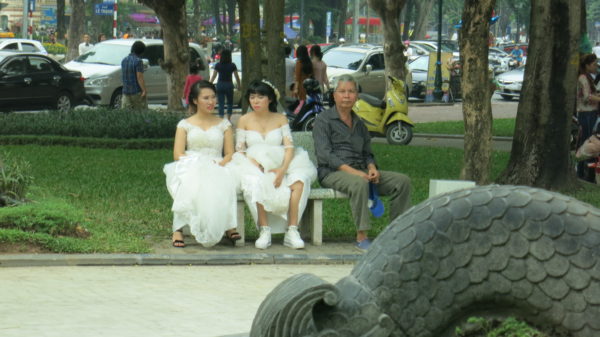
The hotel, special dinners, all signed and sealed by our wonderful trip planner, Cambodia Inspiration, and delivered by our charming, smart, well-informed guide Victor, aka Tran Anh Duc.

Victor
Victor did his job well, taking us to the requisite stops on our itinerary, some of the places in the guide books, among them, the Museum of Ethnology, where we were given an overview of the country’s 54 different ethnic groups and learned, for example, that the country’s signature pointy hats of rattan and bamboo are made by women and worn primarily by women and that the Vietnamese culture itself is 4000 years old. (There’s a copy of a drum dating back that far. The original was fashioned from bronze, an alloy, which means it is not a naturally occurring substance. The drum was also beautifully inscribed with symbols of life at the time. To date, even modern technology has not been able to puzzle out how the object was made.)
We visited Vietnam’s first university, the Temple of Literature where, back in the 11th century, the children of royals learned to follow the teachings of Confucius – whose testosterone-infused, hierarchical philosophy dominated the culture for years, but is now on the outs; gender equality in. In fact, the president of Vietnam’s parliament and the vice-president of the country are both women.
We stopped at the beautiful Ngoc Son Temple beautifully sited on Hoan Kiem Lake and accessed by a charming wooden bridge. There’s a story around that place of heroes, a magical turtle and a sword which does a disappearing act. The patio outside the pavilion is lined with bonsai trees. Did you know their differently distinctive shapes have names like the grandpa tree, the dragon tree, the husband and wife tree and so on. None of that is in the books. Thanks again, Victor.
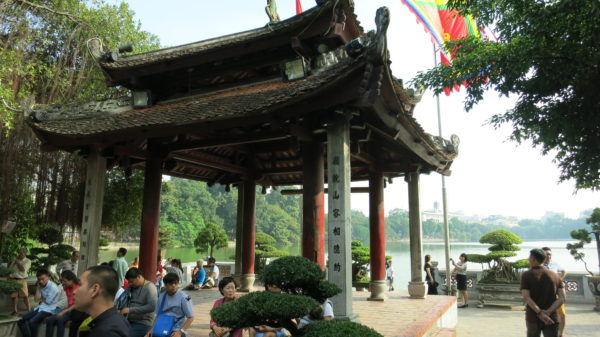
De rigeur is a stop at Ho Chi Minh Mausoleum, where the remains of the national hero, the father of the nation, rest, a campus that includes the Presidential Palace, One Pillar Pagoda, and his Stilt House.
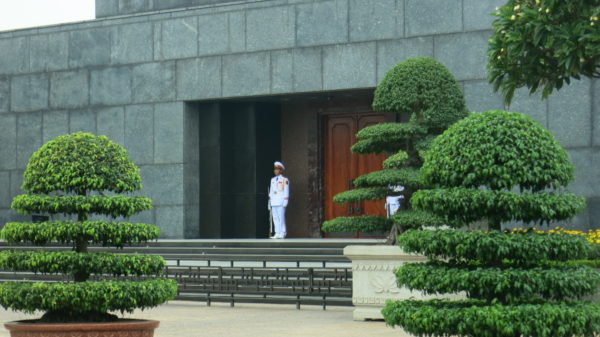
Only “Uncle Ho” – everyone’s pet name for the man whose adopted name means “Bringer of Enlightenment” – was not home.
His remains are currently on sabbatical in Russia.
But the man is clearly revered, even among young people like Victor.
Victor explained that although Ho Chi Minh reunified the country in 1975, conditions remained harsh, people were hungry and generally unhappy until 1986 or so when the General Secretary of the Communist Party laid out a bold plan for change: Vietnam would become a hybrid of Communism, but with a social market economy. However, the real impact of the economic initiative was not felt until the 1990s.
It hit home for Victor’s family in 1995, when they bought the very first TV in their little town.
The pace of change quickened in 1999, when the economy opened up to tourism.
Today, Vietnam in general is one of the world’s fastest growing economies, with Hanoi leading the charge.
Is it all sunshine and roses? Not according to the various individuals we were privileged to talk with, many, even those with what seem like cushy jobs in the service sector, tell us they are still poor, still struggling.
Is there obvious inequality like in our country between the rich and the poor?
No, according to Victor, not obvious: you don’t know a person is rich until you walk through their front door. Behind closed doors, it becomes obvious whose fortunes are on the rise.
Victor told us the following story to frame how locals view the haves versus the have-nots:
The rich drive scooters for fun.
The poor drive scooters for life.
The rich hire motorbikes to get draught beer.
The poor drive their scooters to get draught beer
And yet, this is a country, a city, where those growing fortunes for the privileged few and all the modern luxuries they bring coexist with a tradition of fortune-tellers dating back thousands of years:. Victor told us that in order to determine the most propitious date for his brother’s wedding reception, his family consulted a fortune-teller from a nearby town.
Next stop Halong Bay.


Sorry, the comment form is closed at this time.